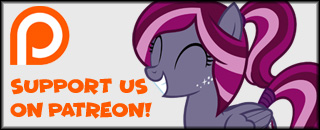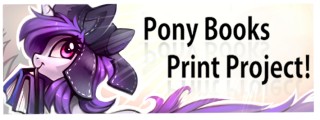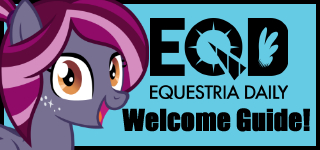TwilightIsMagic is back again with another wonderful interview, this time with fandom artist Cannibalus! What sort of questions has our purple friend picked Cannibalus' mind with? Check after the break for the full interview!
Interested in seeing someone interviewed for the Artist Interviews? Leave your suggestions down in the comments for Twilight to check out.
TwilightIsMagic's dA
Twitter: Calpain
Hello, and thanks for the offer! :) As far as I remember, I’ve been drawing since early childhood. I’ve never studied at an art school, but I often made rubbings of dinosaur cards (I liked dinosaurs very much) and even read an art book. But the older I got, the less I drew and, eventually, about 12 years ago, I went into programming and dropped drawing at all.
In June 2011 MLP invaded my life and 3 months later I got my first tablet to draw ponies. However, it didn't last very long and, after a few pictures, my enthusiasm had faded away. Another year passed and then I decided to start again, in a serious way this time…
- What inspired you to start drawing ponies? Was there anything that struck a chord with you in particular about pony or was it just the entire thing combined?
I saw a lot of fan pictures and comics here on EqD and there was something mind-blowing in the way ponies inspiring so many people to make fan art. I’ve never been a part of any fandom before and it was really new for me. I think that was what inspired me the most – other people’s works.
- Are there any themes, ideas, concepts or styles that you particularly like to go for in your artwork?
As it was, since the beginning of my “serious way” I was attracted to the realistic style, so I mostly learned ways to increase realism in my images. But there was one problem with ponies - they lose a lot of their original cuteness and look strange when drawn in the realistic style, at least in my case. That’s why the “pony robots” theme appeared, I think. I like robots and ponies, so why not combine them? It allows you to paint pictures as realistic as you want, even photorealistic, and they will not look weird.
But although I like realism so much, I also like trying something new – techniques, styles, mediums. Sculpting was the one of such experiments.
- Related to the previous question - what do you like to see in other artists’ work? Preferred styles, ideas, genres, concepts etcetera.
I have no real preferences when it comes to other artist's works. Anything could be in my favorites if it has some interesting aspects like beautiful colors, funny story, cute face, great technical execution etc. But there are some themes I'm not interested in most of the time, for example R34 or gore. Though even in these genres there might be some exceptions.
- Are there any artists, pony or otherwise, whose work inspires or influences yours? What are your inspirations, in general?
There are a lot of artists on DeviantArt and Youtube who inspired me to do some technique experiments at different times. I watched videos and decided to try tricks or techniques used in them. Sometimes it helped to break through artist’s block, so they served as both inspiration and influence. In particular, I'd like to mention Alex Negrea, Dave Rapoza, Sycra and Bluefley. I think these guys influenced me the most.
As for my inspiration in general – it always comes from different things: other artist's works, films, MLP series, fanfics.
- What is the picture you are most proud of, as of this moment, and why?
Sweetie Bot does not like cats. As I mentioned above, realism is my favorite style, and this picture is the closest to my goal at this moment. In addition, it has good dynamics and depth. I know it's not perfect at all. For example, Sweetie's mane is weird and her face is not as cute as it’s meant to be. But the main target was making an image that looks like a movie screenshot and I think it comes very close.
- Do you have any favorites among all of FiM or fan characters, particularly when it comes to drawing them? If yes, are there any specific reasons for your particular liking of them?
Oh, I just love Sweetie Bot! As I like Sweetie Belle the most of CMC and I like robots, the combination of these makes her the best character for me. In addition she has a white body, which can easily fit in every color palette.
- How long does it normally take you to complete your works (the complex digital ones in particular)? What is your creative process like – do you draw things all in one go, in sessions or in another way entirely?
Oh, that is one of my weaknesses - I tend to spend too much time on my works. Some of them took 30 hours and even more, but my average time is about 15-20 hours, I think.
My creative process is not something already formed, it depends on technique very much, but most of the time I can't draw a new picture to completion in one day. Sometimes it can take weeks after the first sketches are made for the final result to appear.
- I see that you have made works in different media – digital and traditional drawings as well as sculpts. I’ve always loved seeing artists work in several media at once. However, I see that your digital art is the most prominent of the three, while the sculpts are few. Are there any particular reasons for that, and are you planning on making more works in those other media in the future? Also, what tools do you use when working in each medium (art programs, type of pencils etc.)?
The main reason of the leading role of digitals in my gallery is that I like the tablet more than any other medium and I can get better results with it. However, sometimes a computer and a tablet are unavailable, and those days are my pencil days. It’s kind of relaxing drawing for me and I don’t pay much attention to it. But my latest drawings led me to the idea of using pencils for sketches and importing them into Photoshop, so there will be some combined pictures coming soon :)
As for my sculpting works – I just wanted to try something totally new. This was a success, but I don’t planning to make more statuettes in nearest future. However, I still have some polymer clay and, who knows, maybe someday this experiment will be continued.
If talking about tools, they would be Photoshop CS5 + Wacom Intuos Pro L for digital works, KOH-I-NOOR HARDTMUTH 1500 HB for sketches and up to 8B for finalization in pencil ones. I don’t use any professional paper – just A4 made for printers.
For sculpting I used FIMO and Sculpey on frames made of paper clips and foil, and some random tools like an old knitting needle or a pocket knife that I found somewhere in my flat.
- You seem to have a great understanding of shading, perspective, light and textures in particular, and it’s apparent in all your works no matter the complexity or chosen style. It’s particularly impressive when it’s applied to complex shapes, such as pony bodies. Is it something that comes to you naturally, or is it something you had to learn or refine a lot? How long did it take?
I can’t say I’ve spent a lot of time learning basics perspective or shading. However, there are some skills I got while being a schoolboy and later on. These skills are not directly related to drawing , but they helped a lot when it came to learning the basics of drawing. For example, I was making paper models of war planes and tanks when I was 14-16 years old. I made all model patterns myself, using drawings of military equipment from technical magazines. It was very good training of spatial thinking that helps to understand volume, surfaces and perspective.
Later, while learning programming I got some experience with 3D rendering and shaders, which gave me an understanding of how light works and also of some post-processing effects.
In addition I learned Photoshop long before I got my first tablet, so I could use other artists’ tricks and techniques instantly after seeing them on Youtube without guessing “what key he just pressed” or something like that.
So it might look like it came to me naturally, but everything can be explained. :)
- One of the most impressive parts of your style is the way you can create a focus on a part of an image, like a camera’s aperture does, with the rest being progressively more out of focus and blurry, and you manage to make it smooth and not obtrusive to the eye. It’s something that I’ve always liked to see. Does it take you a long time to achieve this effect, and is there some special trick you use that you can share?
I suppose you mean the “depth of field” effect. To be honest, it’s not something that is hard to understand. The main idea is that only objects within focus distance are clearly seen, while the rest is blurred. And the farther from the focus distance the object is (in any direction), the greater the blurring you use on it should be. But it’s only one of post-effects and it has its own domain.
There is one more common trick – refine only those parts of image that you want the viewers to look at. The rest of picture surface might be undetailed and even rough, but if you’ll give attention to the things that really matter, most of the times it will look better than over-detailed surface where eye can’t catch anything certain. It doesn’t mean you can’t make a highly detailed picture look good. There are many ways to add or just increase the attention effect, for example playing with different contrasts (values, saturation, sizes etc.), but for most beginners it is better to draw in accordance with the rule “less attention equals less detalization”.
A few words about blurring: it’s an easy way to kill over-detailing on background and give attention to some objects. But not everything that is easy is always good. It’s great for a macro photography, motion or depth of field effect, but if you use it to fix the over-detailing problem, you’re doing it wrong. It’s better to not draw many details than spend your time doing it and then blurring it over.
- You’ve become remarkably good at texturing reflective surfaces like metal, plastic, shiny cloth or polished wood. Can you tell us how you distinguish between them, what different features they have that artists need to take into account so as not to confuse them and end up with unintended plastic armor?
It’s funny that you mention plastic armor :) There was one picture (The New Lunar Republic knight) where I failed with the armor material. It looks just like plastic. This failure forced me to learn how to draw metal surfaces and begin to watch related tutorials. But the best results I got were through watching reflections on a glossy saucepan. It was fun to rotate it in different directions, put random items near it and look the ways reflection changes.
As for global advices about materials, try to think about shading in three stages. First is the ambient. It’s the common light of the entire scene, and it gets everywhere, no matter the angles at which light hits the surface. The only thing here is the “ambient occlusion” that comes into play in the corners and shadowed areas. Next stage is the diffuse light. You should know where your light sources can reach and at which angle the light from every source hits every surface (don’t forget reflections). And the third stage is the specular. It’s the reflection effect, where light reflects from any surface directly to the viewer’s eye. It always has a pure light source color no matter what color your object has. And here we have the main difference between metal and plastic materials. In 3D rendering, there is a property of any material called “glossiness”. The higher the glossiness of the material, the more reflective it is. Glossy metal is a very good example of that. And the less glossiness a material has, the more blurred and undefined the specular light is on it. Some sorts of plastic or terrycloth are your examples here.
All these stages are combined through simply adding them together alongside some modifiers.
As a result, you can mix their properties to get different basic materials. For example, plastic has a great sensitivity to diffuse light but weak to specular. Glossy metal surfaces are the opposite – in their case, almost all the light is the specular type and the diffuse is faded.
I’m not sure this “explanation” is sufficient, but I hope it will pave the way to better googling on this theme.
- Whose Cerberus is fluffier: yours or AssasinMonkey’s?
AssasinMonkey’s of course. Look, he has abundant fur even on his muzzle! :)
Cannibalus' Gallery






































